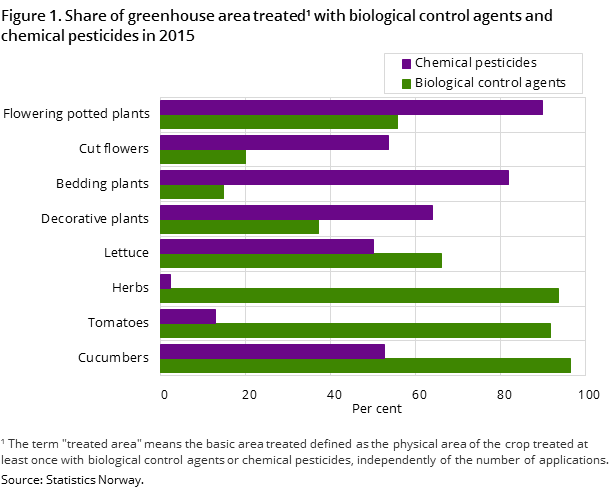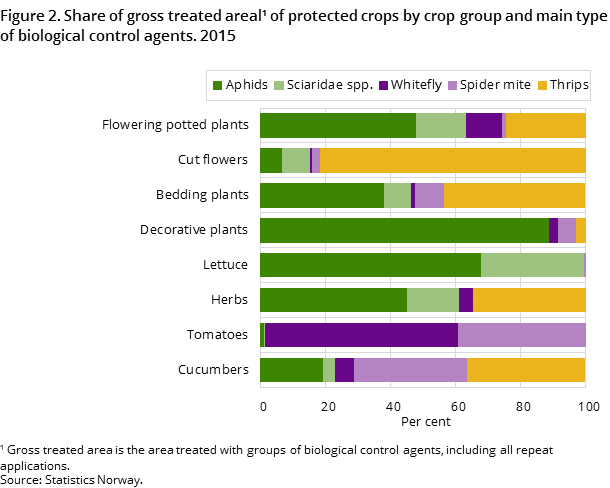Content
Published:
Reduced use of chemical pesticides on greenhouse vegetables
In 2015, biological control agents were applied to 90 per cent of the area of edible crops in greenhouses, while chemical pesticides were used on less than 30 per cent of the area. Within ornamental plants, the corresponding shares were 31 and 83 per cent respectively.
| Holdings with greenhouses, total | Greenhouse area, total (1 000 m²) | Share of area treated with biological control agents | Share of area treated at least once with chemical pesticides | |
|---|---|---|---|---|
| 1Includes flowering pottes plants, bedding plants and decorative plants. | ||||
| Corrected 28 September 2016. | ||||
| 2015 | ||||
| Cut flowers | 22 | 54 | 20 | 54 |
| Ornamental crops1 | 290 | 715 | 32 | 85 |
| Flowering potted plants | 94 | 295 | 56 | 90 |
| Bedding plants | 187 | 408 | 15 | 82 |
| Decorative plants | 9 | 11 | 37 | 64 |
| Lettuce | 31 | 137 | 66 | 50 |
| Tomatoes | 78 | 466 | 92 | 13 |
| Cucumbers | 61 | 360 | 96 | 53 |
| Herbs | 36 | 122 | 94 | 2 |


Most vegetables are treated with biological agents
Examples of biological control agents are insects, fungi and bacteria. For cucumbers, herbs and tomatoes, the share of crop areas treated with biological control agents was 96, 94 and 92 per cent respectively. Within ornamental plants, the average share was 31 per cent. Some areas were treated with both biological control agents and chemical pesticides.
Frequent use of chemical growth regulators in flowers
Growth regulators are mainly used in flowering potted plants. As a whole, growth regulators accounted for more than 47 per cent of the gross area treated with chemical pesticides. Insecticides accounted for 43 per cent and fungicides for 9 per cent. In edible crops, fungicides accounted for 63 per cent and insecticides for 37 per cent of the gross pesticide-treated area. Insecticides were most widespread on tomatoes and lettuce, while fungicides dominated on cucumbers.
Data sourcesOpen and readClose
Statistics Norway conducted its third survey on pesticide usage on protected crops in greenhouses in 2015. The survey comprised the following crops: cut flowers, flowering potted plants, bedding plants, decorative plants, lettuce, herbs, tomatoes and cucumbers.
Contact
-
Berit Bjørlo
E-mail: berit.bjorlo@ssb.no
tel.: (+47) 40 81 13 76
-
Per Amund Aarstad
E-mail: per.amund.aarstad@ssb.no
tel.: (+47) 40 81 13 79
